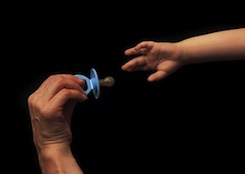 Despite its diminutive size, the pacifier has been the subject of some pretty big debate; some parents and caregivers theorize that pacifier use, even during infancy, can negatively affect the formation of teeth and mouth shape, while proponents hold steady on their value as a soothing device. The American Academy of Pediatrics has even weighed in, stating that their research indicates a marked decrease in the rate of Sudden Infant Death Syndrome among infants that sleep with a pacifier. Whether a pacifier was introduced to your child solely as a comfort object or as a means of reducing SIDS risk, there comes a time when weaning can no longer be delayed. The process of breaking a child from his “binky,” however, can be fraught with hysterics and sleep deprivation for both parents and children alike. While the task of weaning is rarely an easy one to accomplish, these hints can help to soothe the worst of Baby’s anxiety.
Despite its diminutive size, the pacifier has been the subject of some pretty big debate; some parents and caregivers theorize that pacifier use, even during infancy, can negatively affect the formation of teeth and mouth shape, while proponents hold steady on their value as a soothing device. The American Academy of Pediatrics has even weighed in, stating that their research indicates a marked decrease in the rate of Sudden Infant Death Syndrome among infants that sleep with a pacifier. Whether a pacifier was introduced to your child solely as a comfort object or as a means of reducing SIDS risk, there comes a time when weaning can no longer be delayed. The process of breaking a child from his “binky,” however, can be fraught with hysterics and sleep deprivation for both parents and children alike. While the task of weaning is rarely an easy one to accomplish, these hints can help to soothe the worst of Baby’s anxiety.
- Make the Cut – Cutting the rubber tip off of your child’s pacifier alters the way that it feels and reduces its appeal dramatically for most children; while they may feel a bit of confusion about the changes in their prized paci, learning to self-soothe without it is much easier when the pacifier no longer offers the same level of comfort. Be sure to get rid of all the pacifiers except his favorite, and cut the tip off completely to prevent any risk of choking. Explaining to your puzzled little one that his pacifier is “broken” may help him to understand that it can’t be fixed, and is no longer of much value. If you choose this method, don’t attempt to take the mutilated pacifier away; he’ll most likely tire of it on his own and lose interest without a tantrum.
- Bring in a Substitute – Substituting one comfort object for another isn’t always a great idea because it can cause a child to simply transfer his feelings of dependency to the new object when the anxiety of losing his pacifier sets in. Rather than designate one object as special, alternate blankets and other soothing objects that can ease his transition without keeping one particular item in circulation for too long. When bringing a specific object to bed is no longer part of his bedtime routine, eliminating comfort items altogether can be easier.
- Step Up the Soothing and Comforting Routine – If your little one has used a pacifier since the day he came home from the hospital, the transition to binky-free life is bound to be a confusing and scary one for him. The sheer anxiety that accompanies an abrupt shift in the structure of his everyday life can greatly contribute to his difficulty sleeping and irritability during the weaning period, so be sure to allot extra time for comforting words and plenty of cuddling and soothing before bed.
- One Day at a Time – For some kids weaning comes easily and is done over the course of a day or two. The majority of children, however, react with a mixture of anger, confusion, and something akin to grief. Realizing that Rome wasn’t built in a day and that your child probably won’t be weaned from his pacifier in one is the best approach; be prepared to gradually break him of the pacifier habit, rather than throwing them all away in a grand gesture and forbidding them re-entry to the home.
- Rewards and Praise – By the time that pacifier weaning becomes a serious issue for most parents, their children are edging into toddlerhood, and thus are capable of understanding verbal praise, rewards for good behavior, and that these things happen as a result of following instructions “like a big kid.” Every time that your child naps without his paci or completes other tasks, be sure to praise him effusively and let him know that you’re proud of his efforts.
- Patience is a Virtue – If your child is firmly attached to his pacifier as a comfort object, even the best method of weaning will just reduce his anxiety, rather than eliminating it altogether. Realistically, he will almost certainly cry and become angry until he understands that his distress doesn’t deliver his pacifier back and he learns to self-soothe without it. Keeping a firm grip on your patience and working with him through the process to minimize his stress is the most effective way of weaning; unreasonable and unrealistic expectations will only come back to haunt you both.
If your child simply isn’t adjusting to the weaning process and is showing no progress in controlling his tantrums or self-soothing, discussing alternate weaning methods with his pediatrician might give you some more insight.
Taken From Live-In Nanny
No comments:
Post a Comment